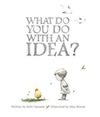
This is the story of one brilliant idea and the child who helps to bring it into the world. As the child’s confidence grows, so does the idea itself. And then, one day, something amazing happens.
This is a story for anyone, at any age, who’s ever had an idea that seemed a little too big, too odd, too difficult. It s a story to inspire you to welcome that idea, to give it some space to grow, and to see what happens next. Because your idea isn t going anywhere. In fact, it’s just getting started.
See the review at WOW Review, Volume 8, Issue 4
- ISBN: 9781938298073
- Author: Yamada, Kobi
- Illustrator: Besom, Mae
- Published: 2014, Compendium
- Themes: Creativity, Inspirational, Self-esteem
- Descriptors: Picture Book, Primary (ages 6-9), United States
- No. of pages: 36

Prisca:
What Do You Do With An Idea? is such a rich book about creativity and the power to change the world with an idea! I identify so much with not knowing what to make of an idea in the beginning, worrying what others will think if they hear it, and liking it more and more as it grows until it blossoms. Many ideas are revised a number of times before they fully “work”. That concept isn’t obvious in the book but I think it’s there in how the boy protects it and cares for it. What do you think about the book?
Ray:
This book is an amazing book on many levels. There is a famous saying that artists are first problem creators, and then become problem solvers. They first think of an idea and set about bringing that idea to the world visually. It is always an artist’s dream that these ideas will change the visual world of art creation. In the process of solving the problem the original artist idea might go through make changes or revisions. What starts off as a world without color might blossom into a work of many colors, or as seen in the book illustrations, a world of many rainbows. That idea “egg” will hatch and become a bird of untold beauty, as is illustrated in ending pages of the book.
Prisca:
Yes, I like the use of contrast too. The black-and-white (except for the “idea” egg) on the beginning pages in contrast with the color at the end when the idea comes to fruition really emphasizes the meaning. There are some illustrations, though, that I don’t quite understand. In many of the illustrations, for example, the trees seem to be underground or are laying on the ground. Do you have any insights into that? Or, any insights into why the particular animals in the book were selected?
Ray:
The images of trees appearing to lay on the ground or underground are a wonderful compositional device. Artist know that there are visual entrances and exits within a given composition. When the artist first has you enter into the image you are then guided visually to the center of interest within the composition. This is known as line of direction. Notice how these tree branches visually guide to the centers of interest which are both the boy and egg. They create a wonderful sense of movement generally from left to right with many of the illustrations. Center of interest (emphasis) is one of the elements of art. Movement is one of the principles of design. The elements of art and principles of design make up the core of the universal language of visual art. If someone is familiar with the four cueing systems in language arts, the equivalent in the sign system of visual art is grapho/phonics (elements of art) and syntax (principles of design). As to the animals being used in the illustrations, animals are used by artists in many different forms of visual images. They are a great substitute for human images. They add a very comforting aspect to a visual image.